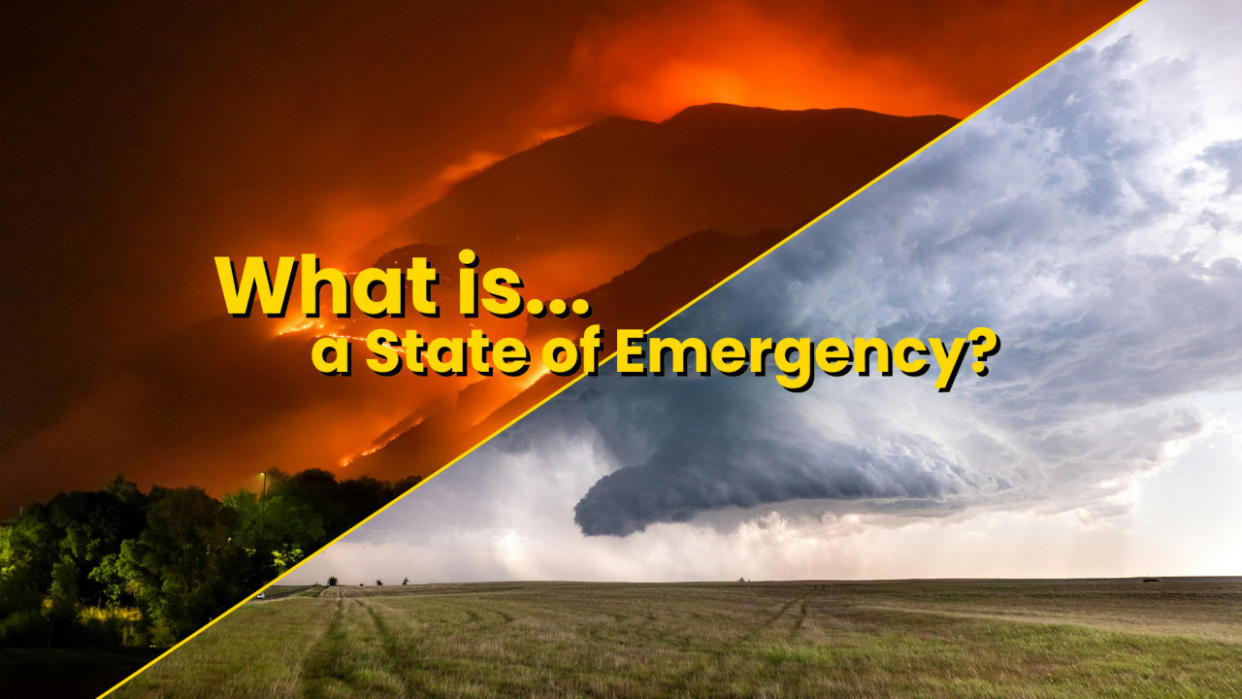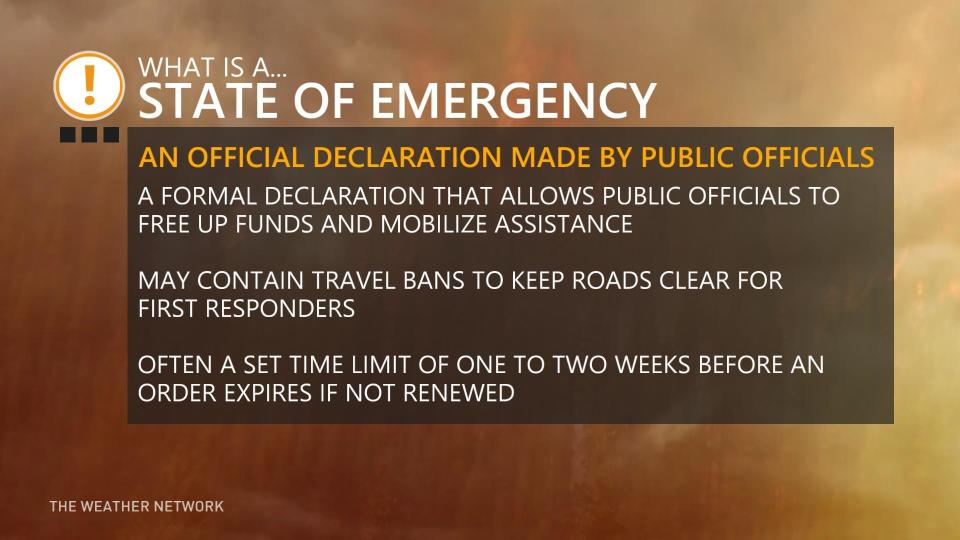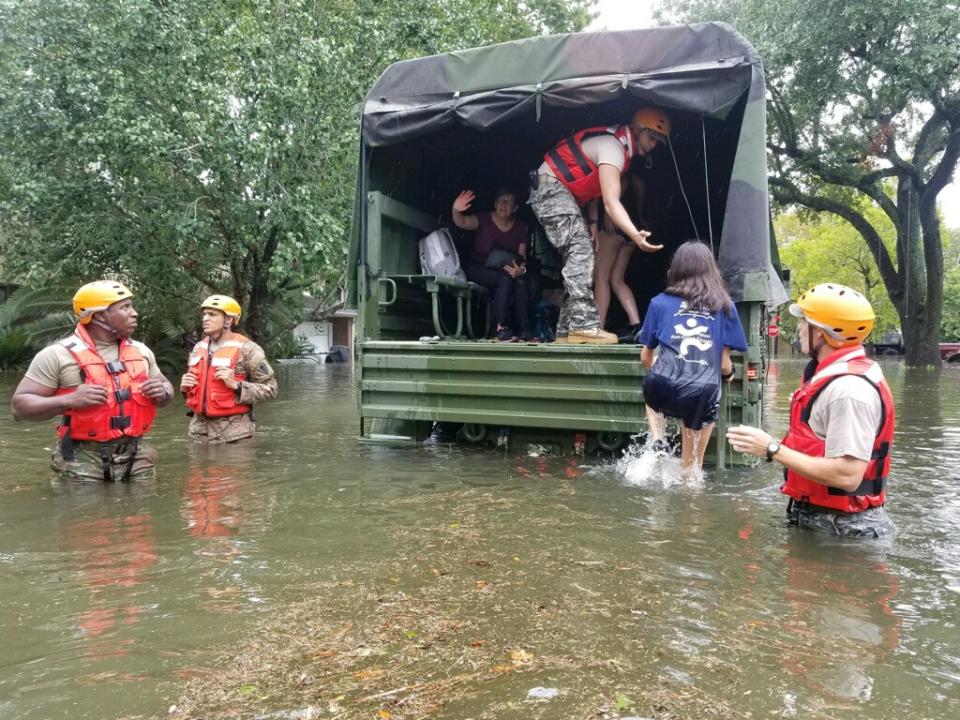What is a state of emergency? How these orders help in a crisis

Time is everything in an emergency. Seconds count when victims are trapped in ruined buildings, survivors need somewhere to sleep at night, and entire communities are reeling without food, water, or electricity.
One of the first tools available to public officials in the lead-up to and aftermath of a major event is declaring a state of emergency.
The phrase itself brings to mind scenes of cinematic chaos—growling skies, billowing smoke, and residents fleeing danger. But state of emergency declarations are hardly ever as dramatic as they sound.
Here’s a look at how officials use states of emergency to quickly respond to crises and other disruptive events.
DON'T MISS: Watch? Warning? How we communicate severe weather in Canada
What is a state of emergency?
A state of emergency is a formal declaration that allows public officials to free up funds, mobilize assistance, and temporarily harness powers they otherwise wouldn’t have on a normal day.
Specific legislation governs when these declarations may be made, how long they can last, and exactly what powers and funds may be used for the duration of the emergency. There's often a set time limit—usually one to two weeks—before an order expires if it's not renewed.

The extra money released by a declaration could fund everything from firefighting efforts and debris removal to the distribution of meals and bottled water.
If there’s a major blizzard, for instance, declaring a state of emergency could allow officials to issue a travel ban to keep the roads clear for first responders and snow plows.
STAY READY: Essential items for your emergency "grab-and-go" kit
A state of emergency during major flooding or a hurricane may allow officials to repurpose schools and community centres as evacuation shelters for residents forced to flee their homes.
Many municipalities incorporate consumer protections into their planning, as well.
Ontario’s Emergency Management and Civil Protection Act explicitly prohibits “charging unconscionable prices in respect of necessary goods, services and resources” during a crisis—in other words, a ban on price gouging.
WATCH: Why Niagara Falls declared a state of emergency for the 2024 solar eclipse
States of emergency aren’t just for natural disasters
There are even some unusual cases where these emergency declarations may prove useful.
Every province and territory in Canada issued a state of emergency at the beginning of the COVID-19 pandemic in 2020 to provide the resources needed to combat the spread of the virus and handle the waves of hospitalizations.
Many communities across the U.S. and Canada issued a state of emergency ahead of the solar eclipse on April 8, 2024, including Niagara Falls, Ontario. This maneuver freed up money so first responders, sanitation departments, and infrastructure crews could handle the immense influx of tourists expected in the region that afternoon.
Niagara Falls expected one million visitors ahead of the 2024 eclipse—a tremendous strain on local resources amid a surge that would temporarily balloon the region’s population from about 100,000 residents to 1.1 million people on a single afternoon.
WATCH: Could emergency alerts be impacted by the total solar eclipse?
Laws are different from place to place
States of emergency are common across Canada and the U.S. given the two countries’ significant exposure to natural and human-caused calamities.
Laws are on the books at the national, provincial, and local level to handle crises across Canada, though most states of emergency are declared at the local level. Provincewide states of emergency are relatively rare—so much so that there’s a Wikipedia page dedicated to tracking each instance.
You can learn more about Canada's national and provincial emergency response plans and legislation through each government’s website:
Federal | BC | AB | SK | MB | ON | QC | NB | NS | PE | NL | YU | NT | NU

Members of the Texas National Guard help evacuate residents from flooding near Houston during Hurricane Harvey in August 2017. (via Flickr)
State of emergency declarations are far more commonplace in the United States, where they have much the same effect as they do in Canada.
State governors and local officials often have broad powers to declare a state of emergency in response to a major incident. In many cases, it’s also a legal step required before a state is allowed to ask the federal government for assistance.
One unique aspect of emergency response in the U.S. involves deployment of the national guard, which is a state-run military reserve force operated by each of the 50 states. A state of emergency can enable a governor to deploy these reserve troops to organize and run disaster rescue, recovery, and cleanup.
WATCH: Don't fall victim to these dangerous tornado myths
Header image created by the author using imagery from Unsplash.

